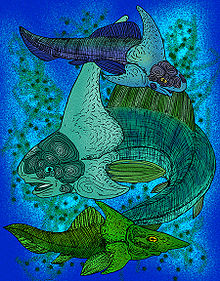Acanthothoracid
| Acanthothoraci Temporal range: Early to Middle Devonian |
|
|---|---|
 |
|
| Weejasperaspis gavini, Murrindalaspis wallacei & Brindabellaspis stensioi | |
| Scientific classification | |
| Kingdom: | Animalia |
| Phylum: | Chordata |
| Subphylum: | Vertebrata |
| Infraphylum: | Gnathostomata |
| Class: |
Placodermi McCoy, 1848 |
| Order: |
Acanthothoraci Stensiö, 1944 |
| Families | |
| Synonyms | |
|
|
Weejasperaspididae †
Hagiangellidae †
Palaeacanthaspidae †
Acanthothoraci (spine chests) is an extinct group of chimaera-like placoderms who were closely related to the rhenanid placoderms. Superficially, the acanthoracids resembled scaly chimaeras, or (relatively) heavily armored ptyctodonts. They were distinguished from chimaeras by the presence of large scales and plates, a pair of large spines that emanate from their chests (thus, the order's name), tooth-like beak plates, and the typical bone-enhanced placoderm eyeball. They were distinguished from other placoderms due to differences in the anatomy of their skulls, and due to patterns on the skull plates and thoracic plates that are unique to this order.
Fossils of the Acanthothoracids are found in various deposits from the Lower Devonian throughout the world. Fossils of the Palaeacanthaspids are found in Eurasia and Canada, while the Weejasperaspids have only been found in the Taemas Wee Jasper reef, in Southeastern Australia.
From what can be inferred from the mouthplates of fossil specimens, the acanthothoracids were ecologically similar to modern-day chimaeras, being a clique of shellfish hunters. Competition with their relatives, the ptyctodont placoderms, may have been one of the main reasons for the acanthothoracids' extinction prior to the Mid Devonian extinction event.
Three families have been recognized:
Most placoderm experts have reached a consensus that Acanthothoracida is the sister group of the rest of Placodermi, save for, perhaps, Stensioella and Pseudopetalichthyida. This is the result of a careful reexamination of the various members of the Acanthothoracid family Palaeacanthaspidae, in that particular species within that family share various anatomical similarities with other placoderm orders, particularly the anatomies of their braincase, dermal plate arrangement and bone histology. In 2011, the genus Hagianella, of the monotypic family Hagianellidae, was reappraised as possibly being the sister-group of Ptyctodontida due to similarities of skull anatomies. As a result, Palaeacanthaspidae and Hagianellidae are now considered to be paraphyletic due to the similarities their members have to primitive members of other placoderm orders.
...
Wikipedia
